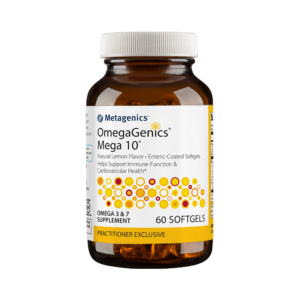
There is a lot of talk today about good fats and bad fats. But what does that mean? Are all good fats equal? What makes Omega-3’s different?
Omega-3 fats are polyunsaturated, or part of the good fat team. They are precursors to prostaglandins and they help reduce arthritis, eczema, headaches, migraines, high blood pressure, ADD and ADHD symptoms, inflammation, auto-immune diseases, osteoporosis, breast cancer and other conditions. Not only do they help prevent diseases, omega-3s can increase the growth of neurons in your brain and are associated with higher intelligence and improved memory function. Omega-3s help reduce your risk of heart disease by creating more stable arterial plaque. Omega-3s even reduce the risk of prostate cancer. One University of California study found that men who ate dark fatty fish, high in omega-3s (Tuna, Salmon, etc.), one to three times a week had a 36% reduced risk of prostate cancer compared to those who did not eat fish. The greatest reduction of cancer was among those who had a genetic tendency.
So, what are some sources for omega-3s? You can find omega-3s in the following:
deep water fish
flax seeds, chia seeds, and hemp seeds
walnuts
green leafy vegetables
pastured eggs
canola oil, flax oil, and walnut oil
Omega-3s are so important to your diet that you need to ensure they are the first-pick for your fat consumption. There are other fat sources that fall into the good fat category, such as corn oil, soybean oil, safflower oil, sesame oil, sunflower oil, nuts, seeds, and legumes, but they are rich in omega-6s. Although omega-6 is essential to the diet, Americans tned to consume excessive amounts of omega-6, so the challenge is to find the best omega-3s that don’t also contain omega-6s. The best way to balance your omega-3 to omega-6 intake is to eat fish twice a week and minimize your intake of omega-6 rich vegetable oils such as the oils listed above. It is important to eliminate all fried foods and also limit processed foods, since even though the ingredients may list a good fat, the fat is often destroyed by or oxidized by heat.
Interestingly, there are two specific types of omega-3’s: marine animal and plant based. The omega-3s from fish are more bioactive and better able to be used by the body. Marine animal omega-3s contain EPA and DHA, which have more cardiovascular benefits than the plant based sources of omega-3s that contain ALA. The plant based ALAs can be converted to EPA and DHA, but this requires the use of enzymes. Therefore, best sources for omega-3 consumption are wild salmon, herring, sardines and tuna fish, although tuna is often high in mercury, so needs to be consumed in moderation. These have the best bang for your buck, as far as omega-3s go. Some fish contain only 6% of the amount of omega-3s as other fish, so it’s important to consume the right fish oil.
If you’re looking to increase your omega-3 intake or battling one of the conditions mentioned, our ESSENTIALS line have several variations you should consider!
Not sure what you need? Set a time for a private consultation with Joyce Gibb, MS, CNRP: (412) 826-9500 and ask for Terri.
Resources:
Balch, Phyllis. Prescription for Nutritional Healing.
Leitzmann MF, Stampfer MJ, Michaud DS, et al. Dietary intake of n-3 and n-6 fatty
Acids and the Risk of Prostate Cancer. Am J Clin Nutr. 2004; 80:204-16.

